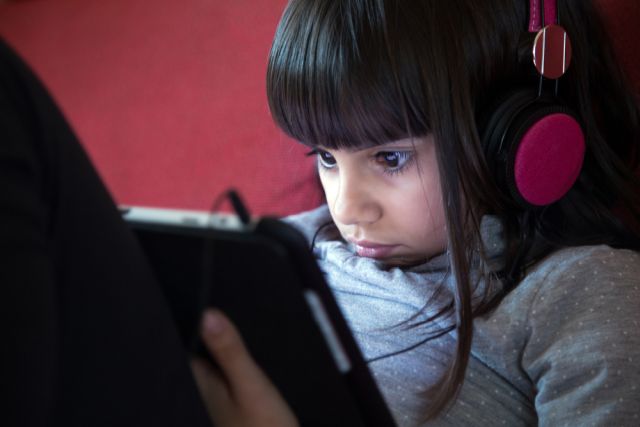Sensory Processing
How does screen time affect brain development
How does screen time affect brain development is often asked by parents. In today’s world, laptops, smart phones and touch pads abound and it is increasingly convenient to turn to these devices. You sometimes wonder how much screen time is too much
We regularly plop our kiddos in front of a screen to entertain, distract or even educate them. There is no question that screen time for kids can serve as an on-demand baby sitter. And at times, it is an absolute blessing, offering parents some much needed respite!
However, whether it’s a kids’ TV show, a video game or even an interactive learning tool, the fact remains that children today spend loads of time on screens. And there is a big, unavoidable question that you have been asking yourself. And that is “Does excessive screen time for kids have negative effects on my child’s brain?” or should parents limit screen time.
Sadly, the answer is a resounding ‘yes.’ In fact, evidence is glaringly obvious that even so-called “regular” amounts of time on electronics for kids has negative consequences on both the brain development and sensory processing abilities of our children. This includes their emotional development, too.

Screen Time and Brain Development
There are a few things happening to a child’s brain when interacting with a screen.
Unfortunately, they have both short and long-term detrimental results. The two most cons of screen time on brain development are:
- the effects of blue light emitted from almost every electric screen and
- the hyper fast speed at which visual content on a screen moves
Let’s look at these factors in more detail and examine how the human brain, especially that of our child’s, responds.
You’ll soon understand why it’s important to begin limiting children’s screen time.
1. How Blue Light Affects Children
Types of light
Natural light, i.e. sunlight, includes the full range of visual spectrum colours of the rainbow. It has a slightly higher proportion of blue light – approximately one third.
On the other hand, fluorescent lights and LEDs, including digital devices like computers, TV’s, tablets, smart phones, etc., are made up primarily of blue light.
Blue light has shorter wavelengths than the far red end of the spectrum and thus also has more energy.
In relation to the sun, highly energized blue light has the desired effect of increasing wakefulness and decreasing melatonin (the hormone that makes us sleepy).
The result is keeping us stimulated and attentive during daylight hours, and upsetting our circadian rhythm. When the sun goes down and the blue light decreases, our melatonin increases and we transition into sleepy-time.
Effects of different light
However, with the increasing popularity of the blue-lit screen, we tend to be artificially stimulated long after the sun has dropped below the horizon. This leads to insomnia, over activeness, and a skewed circadian rhythm.
Studies even show that many people who use screens in the hours before bed have a poorer quality of sleep with less REM time, leading to day time fatigue.
You probably already recognize how important routine is for children – and how important their restful sleep is to you! Keeping screen time relegated to day time hours could be a potential solution to the wakefulness issue.
However, it’s worth pointing out that the same blue light also causes significant damage to our eyes and screen time linked to lower brain development.
Because the shorter waves of blue light scatter more easily, they strain the eye. This is especially so when looking at it with a focused gaze from short distances. Also, unlike long wave red light, blue light is not stopped by the retina.
Instead, it travels straight to the back of the eye, meaning they can have long term damage. This is especially concerning for the eyes of children, which continue to develop through middle childhood. Limiting children’s screen time is important for their eye health.
Potential consequences
So, yes, blue light is naturally occurring within sunlight and is even useful for certain situations. However, the sheer quantity of time people spend looking directly into the blue light of screens at close proximity is highly concerning.
It also has potentially negative consequences on both sleep and eyesight.

2. The Speed of Screen Media
Even more detrimental to children is the speed at which screens project images. This can actually damage brain development. Media entertainment includes hyper-fast shifts in information and visual stimuli.
Visual processing in humans has developed over the ages to process the ordinary day-to-day speed of sensory information. Consider how your heart can be over worked, leading to panting for breath after a workout, for example.
Similarly, your brain also has a limit to how fast it can process information. If the information is coming too fast, the brain will suffer a sensory overload and shut down.
All screens, be they for video games or movies, include accelerated changes. These changes, in turn, speed up the brain to a degree that comes in just beneath the visual sensory overwhelm.
Thus, while the brain does not shut down, it does work really, really fast to keep up.
Reasons for limiting children’s screen time
In a child whose brain is still developing (and especially with children who have sensory processing disorder symptoms, ADD or ADHD), they will need to focus even more acutely in order to keep up with the rapid pace of the incoming information put off by their screen.
This is indeed the very reason why screens are so adept at calming down and quieting a rambunctious child down. Every bit of their brain is absorbed in keeping up with the stimuli before them.
But what happens after you take the screen away? The child’s brain will still be moving at a rapid fire pace. And so it will have a hard time adjusting to the normal speed of normal life.
Thus, a child will typically become hyperactive, bouncing off walls and trying to keep up with the speed of their brain. They’ve lost the capability for self-regulation. In fact, there is evidence that some children who are diagnosed with Hyperactivity Disorder are actually just responding naturally to time spent in front of a screen.
Their brain will eventually recalibrate to the speed of everyday reality. But this takes some time. Over time, their emotional regulation is steadily declining due to the roller coaster that their brain is experiencing bouncing from video to reality and back again.
Sensory System Impairment
Another problematic effect of the rapid-fire speed of screen media is this: while the visual processing part of the brain is in hyper drive, sorting through all the incoming information, the vestibular system is actually put on hold.
The vestibular system is the sensory system that allows for coordination of movement and balance together. It is the system that orients us in space. It is responsible for helping us stay upright and see clearly even while we are walking.
And it also has a huge effect on mood. While linear acceleration, such as walking, rocking, or driving, has a calming effect, rotational acceleration, like spinning, is arousing. An out-of-synch vestibular system can lead to depression and anxiety.
The effects of a screen
When watching a screen, the vestibular system is effectively turned off as all the energy of the brain is visual processing mode. In this mode, brain is essentially hypnotized by the images.
This is why it is so easy to phase out on a screen. And it’s why you can put an upset child in front of media entertainment and they will transform almost instantly, gazing at the screen without emotional outbursts.
Hence, the light-hearted term being used today: zombie children, and their older counterparts: screenagers.
Their mood is literally switched OFF.
And when the screen is inevitably taken away? Mood swings and meltdowns are a likely result as the brain and body comes back into balance.
A solution
A good solution to the immediate transition from screen to non-screen, is to have your kiddo jump, run and do something super physically active immediately after TV or Video Game time.
This helps to reset the vestibular system, which will calm the body. And it also helps with the hyper fast brain pace that needs stimulation until it has a chance to slow down.

Limiting children’s screen time is ultimately the only solution, but is not always an easy option.
Long Term Consequences and Solutions – Reasons for Limiting Children’s Screen Time
It is not completely understood what the long-term effects of screen time on child development are. However, it is not hard to reason that transitioning out of screen time causes significant stress on the brain and nervous system.
There is also concern that children are learning to process media at super fast speeds, but are losing the skills needed in normal reality that involve slower transition times.
Children are not learning to deal with emotions while behaviour problems are exacerbated by the media “band aid.” There is also evidence that screen time retards the development of the frontal lobe.
The frontal lobe is the part of the brain which is actually responsible for controlling emotions, attention span and empathic skills. While watching tv or playing video games alone don’t cause sensory issues in children, it definitely makes them worse.
So how does screen time affect brain development: Understanding the effects of excessive screen time for kids
It’s completely understandable that most people reach for media entertainment these days when they need a break – for yourself and for your children. You have million things going on. You’re tired, and kids who are vying for your attention can be stressful.
Don’t be hard on yourself, Mum & Dad. A lot of us have fallen prey to the easy solution of using a screen as a go-to for a rowdy child. Children and technology are growing up together. And we’re doing our best to stay ahead of the problems created by it.
But we hope that by understanding fully the effects of screen time on children, parents might start working toward other solutions.
There are many strategies you can implement to help ease the transition (for both parent and child) out of using so much screen time. Limiting children’s screen time is the beginning.
And as always, we are here to provide support and guidance along the way with any transitions you and your family implement!